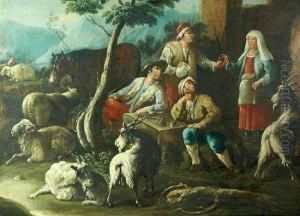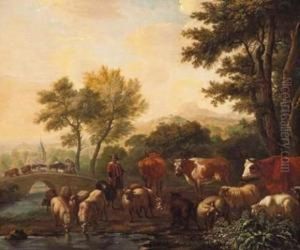Philipp P. Roos Paintings
Philipp Peter Roos, also known as Rosa da Tivoli, was a German painter who was born in 1655 in Frankfurt am Main, Germany. He was part of a family of painters, being the son of the landscape painter Johann Heinrich Roos, and he was one of several artists in the Roos family. Philipp Roos is particularly known for his depictions of animals and pastoral scenes, which exhibit a strong sense of realism and attention to detail.
Philipp Roos received his initial training from his father, who was an accomplished artist in his own right. His early exposure to art within his family environment played a crucial role in his development as an artist. In 1677, Roos traveled to Italy, which was a common practice among artists of the period seeking to study the masterworks of the Renaissance and the vibrant Italian art scene. He settled in Rome, where he would spend the majority of his life and where he earned the nickname 'Rosa da Tivoli,' after the town of Tivoli near Rome where he often worked.
While in Italy, Roos was influenced by the work of the Dutch and Flemish painters who were active in Rome at the time, such as Karel Dujardin and Nicolaes Berchem, who were known for their pastoral and bucolic scenes. Roos’s works often featured animals such as sheep, goats, and cows, depicted with a naturalistic style in idyllic Italian landscapes. His ability to paint animals with such lifelike qualities and expressive character became his signature, and it was admired and sought after by patrons.
Throughout his career, Philipp Roos enjoyed considerable success. He worked for prominent patrons, including the princely family of Liechtenstein, and his works were collected by art connoisseurs across Europe. His paintings were characterized by their warm color palette and the harmonious integration of figures within the landscape, which reflected the influence of the Italian setting.
Roos's influence extended through his own family, as his sons, particularly Johann Melchior Roos, continued the tradition of painting and helped to perpetuate their father's style and subject matter. Roos’s work contributed to the genre of animal painting in the Baroque period, which was an important aspect of European art, particularly in the 17th century.
Philipp Peter Roos passed away in 1706 in Rome. Today, his work is represented in several important art collections and museums around the world, testifying to his lasting impact on the art of animal painting.

